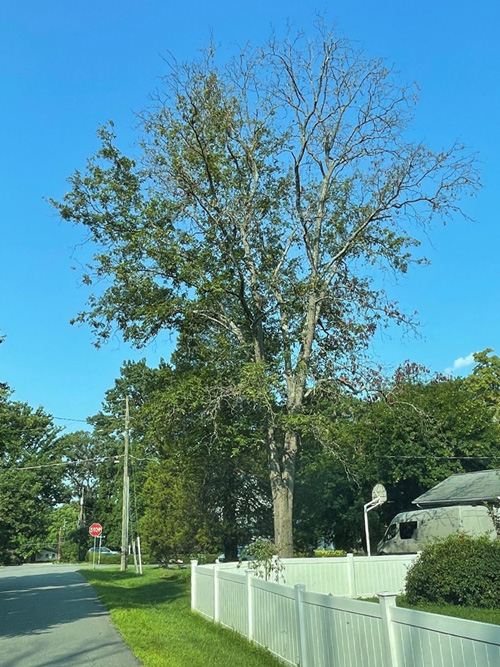 What is oak decline?
What is oak decline?
Oak decline is a condition that affects oak trees and is characterized by a number of symptoms, including leaf yellowing, sprouts on the trunk and limbs, browning leaves, and thinning of the canopy. It can also cause the death of small twigs and larger branches, and over many years or decades, lead to tree death. The cause of the widespread decline of oak trees is believed to be the result of a combination of factors including tree age, environmental stress, pests and diseases, and improper care.
How Does an Oak Tree Die?
In a healthy tree, water from the roots moves up to the canopy to support photosynthesis. The food produced from photosynthesis moves down to the roots to support respiration. When drought and defoliation disrupt this process, the stressed tree must consume its food reserves until photosynthesis is resumed. Young trees can bounce back from these stressors, but older trees are more vulnerable to disturbances and may never fully recover the balance between photosynthesis and respiration. As food reserves dwindle tree growth begins to slow and the canopy gradually dies from the top down. Already in a weakened condition, the tree is more vulnerable to insect and pathogen attacks. Eventually, food reserves are depleted, the tree succumbs to fungal and insect attack and respiration ceases.
What Does Oak Decline Look Like?
Visual symptoms of oak decline vary among oaks and can progress gradually over many years or appear suddenly over several weeks. The photos below are examples of declining oaks in Fairfax County.
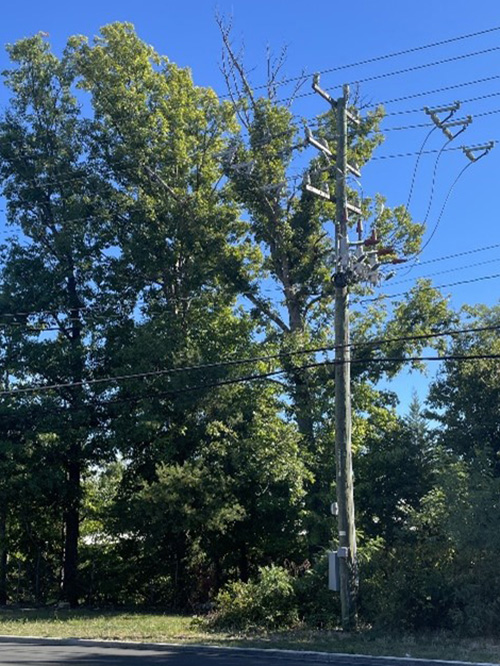
This oak is showing twig and branch death at the top and new sprouts along its limbs, giving the branches a bushy appearance.
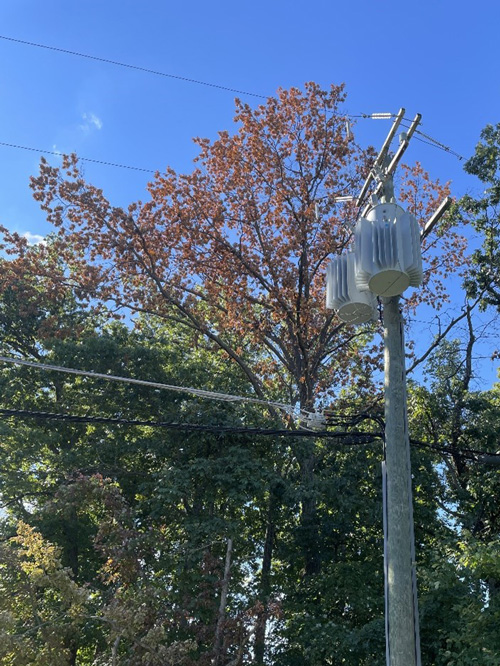
This oak appears to have leafed out in the spring only to have all its leaves turn brown in September.
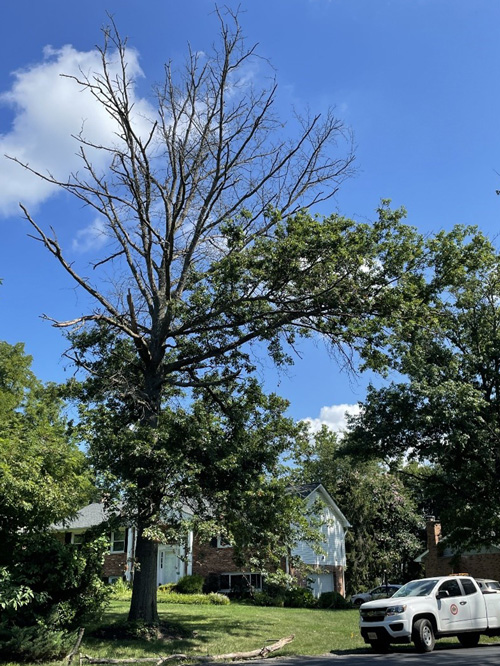
An oak in advanced stages of decline. Only its lower branches can produce leaves.
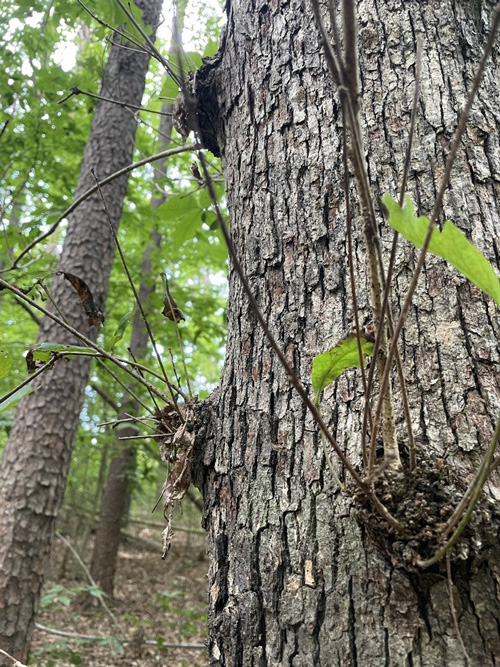
New sprouts on the trunk and large limbs, called epicormic sprouting, are produced by the tree in response to stress.
Similar Symptoms
Oak decline is often confused with sudden oak death and oak wilt because a stressed oak could exhibit symptoms that resemble these diseases, like sudden browning of the canopy. However, there are currently no lab confirmed cases of either disease in Virginia.
Are my oaks vulnerable to oak decline?
To understand why we see oaks dying in Fairfax County we need to look back at how humans have shaped today’s hardwood forests over the past three centuries. Prior to the arrival and expansion of European settlers in Virginia, fires from lightning and controlled burns created forests with diverse species and age classes. By the turn of the 20th century, most of the land had been burned and logged for wood procurement and agricultural development, which favored fire-resistant species like oaks. Enactment of fire suppression and land conservation policies during this time allowed the existing oak forests to become dense with fire-intolerant species. Fairfax County was mostly agricultural until the mid-1900s when the land urbanized quickly. What remains today are mixed woods with a generation of mature and overmature oaks from the turn of the 20th century, which have survived devastating spongy moth infestations and droughts. These old oaks may appear to die suddenly and without reason, but, in fact, they have weakened over many years of stress until they could no longer defend themselves from otherwise harmless pests or diseases.
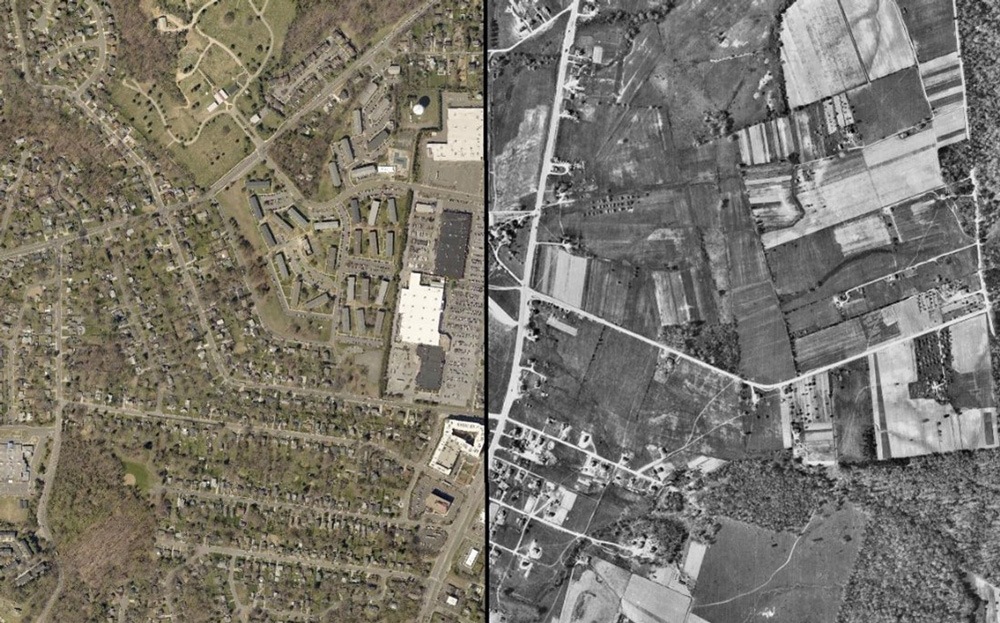
Today Fairfax County is predominantly suburban with some urban areas, as shown in the photo on the left from 2022. However, land uses in Fairfax have traditionally been agricultural, as shown in the photo on the right from 1937.
There are several different types of oak trees that can be affected by oak decline , including red oak, white oak, chestnut oak, and black oak. Oak decline is most commonly found in mature or overmature trees, and it tends to be more severe in trees that are already stressed or in poor health. Oak decline can be difficult to diagnose because it is a combination of factors, rather than any single factor, that contribute to the tree’s decline.
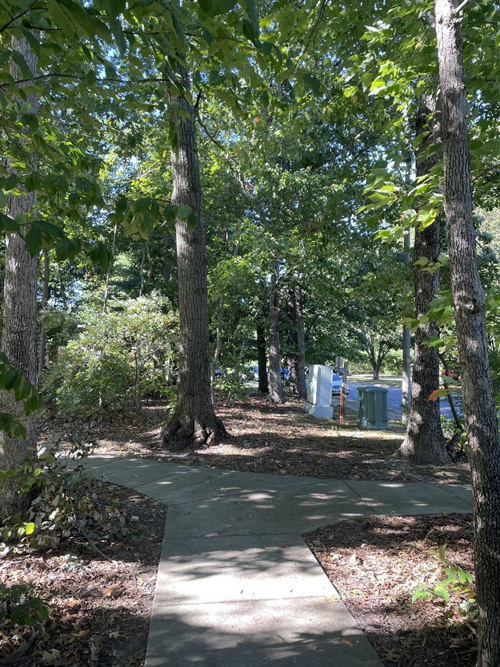
Urban trees along this sidewalk contend with soil disturbance, constrained roots, and salt spray from the road.
Under ideal conditions the life expectancy of oaks is between 100-300 years depending on the species. However, trees growing in urban environments typically live much shorter lives than trees growing in natural settings. Urban trees are subjected to more frequent and severe stresses such as compacted soils, restricted root space, competition, heat island effects, and damage from construction.
How Can I Prevent Oak Decline?
There is no cure for oak decline. The best course of action is to take preventative measures to keep oak trees healthy. These may include proper watering, mulching, pruning, and pest management (see below). In cases where oak decline syndrome has already progressed to the point where the tree is dying, it may be best to remove the tree to prevent hazardous situations.
Seeing your treasured oak tree slowly die is difficult, but the time for applying preventative measures has likely passed once your tree has lost more than a third of its canopy. Be cautious of treatments that promise to reverse or stop oak decline. At best they will only delay the tree’s inevitable death.
You Can Help Prevent Oak Decline
There are several steps you can take to help prevent oak decline syndrome in your oak trees. By following these steps, you can help keep your oak trees healthy and reduce the risk of oak decline syndrome.
- Proper watering: Oak trees need an adequate supply of water to stay healthy, so make sure to water them regularly and deeply. Let a hose run on a low setting for 30 minutes a week during a dry spell. Avoid over-watering, as this can lead to root rot.
- Mulching: Proper mulching can help oak trees grow strong and healthy. Never apply mulch against the trunk and apply only up to 3 inches deep. A wide ring around the tree at least as far as the branch tips is good and it can be expanded as the tree grows. Consider replacing the turf around your trees with mulch. Turf competes with trees for valuable root space and resources. Eliminating turf around your oaks will increase the amount of water absorbing tree roots and promote beneficial mycorrhizae. If possible, take mulching a step further by adding twigs, small branches, and leaves to re-create a natural forest floor. Leaves blown by the wind will get caught and help produce a very nice moisture retaining mulch that slowly releases nutrients back into the soil.
- Pruning: Remove dead, damaged, or diseased branches for safety. Pruning can be dangerous and stress trees if performed improperly. It’s best to limit pruning to what you can do safely and properly. We recommend hiring a certified arborist who can prune your trees in accordance with industry standards. For more information about pruning please see the Fairfax County Tree Basics Booklet.
- Avoid damage: Do not allow mowers and trimmers to come close to the tree trunk or roots. Damage to this area can invite pathogens into the roots, which is especially bad for the tree. Add a mulch ring around the tree to keep equipment away from the trunk and roots.
- Planting healthy trees: When planting new oak trees, choose healthy specimens from a reputable nursery and follow proper planting guidelines. Give new trees plenty of space for their canopy and roots to grow to their mature size. Remember, right tree right place!
- Hire a professional: A certified arborist can help you decide how to best care for your trees. Select an arborist that belongs to a professional organization such as the International Society of Arboriculture (ISA), the Tree Care Industry Association (TCIA) or the American Society of Consulting Arborists (ASCA). Please visit TreesAreGood.org to find a professional tree care provider. For more information about certified arborists please see How to Hire an Arborist or Tree Care Company.
Oak Decline Resources
For more information about oak decline and how to care your trees please visit these sites,
Tree Planting and Care | Public Works and Environmental Services (fairfaxcounty.gov)
Webinar: Fairfax County Oak Tree Decline Webinar - Oct 19, 2022:

